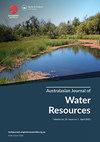澳大利亚东南部墨累-达令盆地南部河流平原灌溉、气候和地下水开采变化造成的河流损失风险
IF 2.2
Q2 WATER RESOURCES
引用次数: 2
摘要
本文章由计算机程序翻译,如有差异,请以英文原文为准。
Risk of stream loss from changing irrigation, climate and groundwater extraction on the southern riverine plain of the Murray-Darling Basin in south-eastern Australia
ABSTRACT The rivers of the south-eastern Murray-Darling Basin (MDB) and the associated irrigation areas of the southern riverine plain (SRP) in south-eastern Australia have undergone major hydrological changes over the last 30 years. These include a period of lower rainfall; a rebalance of surface water diversions between consumptive and environmental water uses under the MDB Basin Plan, improvements in water infrastructure; water trade out of the region; and falling groundwater levels. All these changes increase losses from streams to groundwater systems; potentially leading to the need for greater releases from dams to maintain baseflow in the major rivers. Baseflow is important for conveyance of water, water quality and baseflow-dependent ecosystems during dry periods. Hydrological changes in the SRP will reduce the streamflow by 2029–30 by an estimated 80 to 320 GL/yr. Further hydrological changes by 2029–30 will reduce the streamflow by another 50 GL/yr in the following decade. This is the first assessment of the cumulative stream impacts of the SRP and is relatively lower than previous assessments for single drivers. The current approach of mitigating unexpected losses is to increase conveyance loss budgets as required. This could be extended to mitigate the lower end of potential impacts; but further steps to reduce losses may be required towards the upper end. Further actions include a review of extraction limits for surface water and groundwater, trigger levels, and a greater shift towards conjunctive water management. Groundwater extraction, which has dominated impacts, is increasing from a relatively low proportion of the extraction limit in Goulburn-Murray Sedimentary Plain and shallow aquifers of the SRP. Over time, climate change will become more dominant as a driver. Most monitoring required to support mitigation already exists, but data is not collated or reported in a form relevant for stream impacts. Modelling also needs to be updated with reporting of more relevant outputs.
求助全文
通过发布文献求助,成功后即可免费获取论文全文。
去求助
来源期刊

Australasian Journal of Water Resources
WATER RESOURCES-
CiteScore
5.10
自引率
21.90%
发文量
25
期刊介绍:
The Australasian Journal of Water Resources ( AJWR) is a multi-disciplinary regional journal dedicated to scholarship, professional practice and discussion on water resources planning, management and policy. Its primary geographic focus is on Australia, New Zealand and the Pacific Islands. Papers from outside this region will also be welcomed if they contribute to an understanding of water resources issues in the region. Such contributions could be due to innovations applicable to the Australasian water community, or where clear linkages between studies in other parts of the world are linked to important issues or water planning, management, development and policy challenges in Australasia. These could include papers on global issues where Australasian impacts are clearly identified.
 求助内容:
求助内容: 应助结果提醒方式:
应助结果提醒方式:


